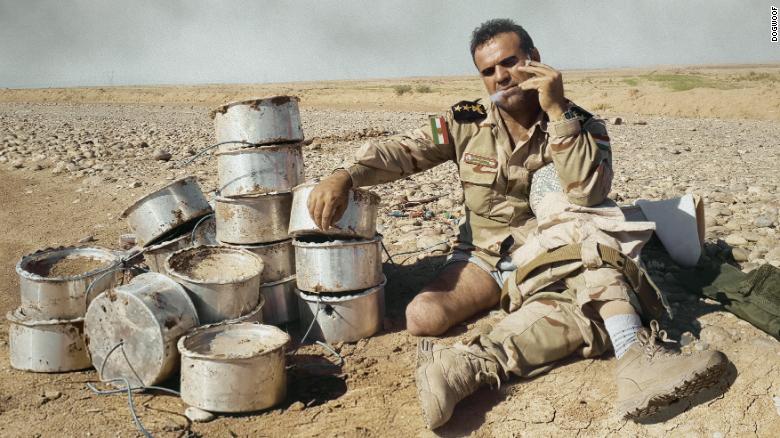Walk around the streets of Duhok, northern Iraq, and you'll see the same face staring back at you. Stoic and square-jawed, the inscrutable portrait is a common sight behind shop counters and stalls in this city, a short drive north from Mosul.
Everyone in Duhok has heard of the man known as "Crazy Fakhir." For over a decade he risked his life to ensure others' safety; a local hero who removed landmines with nothing but a knife, wire cutters and quick wits.
Now his story is being told in a new feature-length documentary that has been described as a real life version of Kathryn Bigelow's Oscar winning film "The Hurt Locker."
Fakhir Berwari first demined as a soldier alongside the American-led coalition, following the invasion of Iraq in 2003. He risked death for years in and around Mosul, surviving near-misses and the loss of his right leg to a mine in 2008. Wearing a prosthetic limb, Berwari returned as a colonel in the Kurdish Peshmerga, neutralizing booby traps left by a retreating ISIS.
Exactly how many mines the colonel successfully disarmed is unknown, but it is believed to be in the thousands. However, in November 2014 Berwari paid the ultimate price when he was killed in an explosion while clearing a mine-riddled house.
Each chapter of this remarkable story, through to its shattering conclusion, was captured on camera. Unbeknownst to his family, hours of footage were recorded by his colleagues and stashed away by Berwari on DVDs in a battered old briefcase. Three years after his death, the briefcase was discovered by Berwari's son, Abdulla.
This cache from 2003-2008, paired with video shot in 2014, comprises the backbone of "The Deminer," co-directed by Hogir Hirori -- born in Duhok but now living in Sweden -- and Kurdish filmmaker Shinwar Kamal.
Sustaining unbearable tension and pockmarked with extreme violence, the film joins a roster of recent award-winning documentaries including "The White Helmets" and "Nowhere to Hide," stemming from Iraq and the ongoing conflict in Syria.
Before its UK release, CNN sat down with Hirori to discuss Berwari's unimaginable courage and the film's difficult journey to screen.
Hirori: In 2014, ISIS was attacking areas in Iraqi Kurdistan. I was there making another documentary and I happened to see Fakhir. I knew about him; in our area he was portrayed as this local hero. I went up to him and asked about making a film. He said: "No, sorry, you can't. Take my advice: go home to Sweden where it's safe and stay there."
But then as we started talking Fakhir said: "Well, there is actually this guy who's just recently started making a film about me called Shinwar Kamal. If you want to do something go and talk to him, because we can't have two teams running around making two films. It's too dangerous."
Fakhir died three months after I met him. I was in Sweden; I opened my phone and my whole newsfeed on Facebook was filled with pictures of Fakhir. I realized that it was not good. I immediately called Shinwar to ask what happened and if they were ok. He and his team were outside the building (they were demining), but the ones filming inside the building -- Fakhir and his two assistants -- died in the explosion.
When he died the whole film-making process became more complicated. There was an ongoing story that was cut short.
The majority was found in 2017, three years after his death. The material is purely shot by amateurs. One of the people responsible for filming was Fakhir's driver -- he's still a little bit shocked his video is going to appear in a movie.
The footage wasn't dated; there was no logic to it at all. There was a lot of work and time put in to speaking to Fakhir's colleagues and friends to put together the whole puzzle and make sense of it. The process was not clear cut -- that's why it ended up taking 78 versions of the film before we reached the final edit.
Fakhir and his team wanted to document what they were doing so they could show everybody else their work and what they were accomplishing. There was also another purpose behind filming: to show what the mines consisted of, how they were set up, how they were placed and how they were disarmed, so other teams could learn from that. But after a while it just became part of their everyday lives. They always had a camera rolling.


